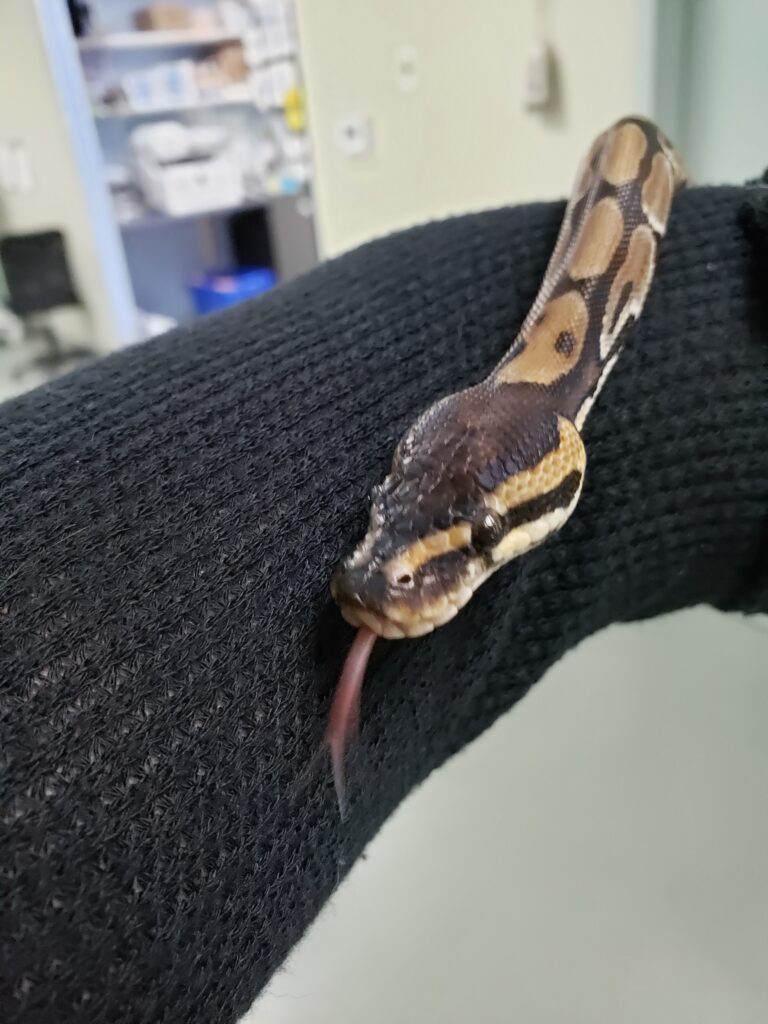Do you want to own a pet snake, or own one already and want to brush up? There is a lot of information out there on the internet about snakes, and not all of it is true. Your veterinarian is the best resource for your snake’s individual need. Each species is unique and needs to be treated in their own special way!
Why would anyone want a snake?
Snakes can make wonderful pets! Once they have an appropriate set up, they are low maintenance and generally easy to handle. Snakes are reptiles, meaning they depend on their environment to regulate their temperature, humidity, and overall health. Thus, husbandry (their housing and care) is the most important part of keeping them healthy. Snakes can be trained using small pieces of their food, and possibly even recognize individual humans! The temperament of a snake does often depend on the species, so for beginners, please consider a captive bred, easily managed snake (e.g. a ball python).
Snakes are not pets that require daily attention, so if you have a busy schedule, they may be a good choice! They are also very quiet, and solitary. Snakes are not slimy, and are very clean as a whole. They do not need to be feed more than a few times a week (even less for some species!), so they are good for frequent travelers. And depending on the species, they can live for a long time with proper care. A ball python lives to be 20-30 years, so do not take the decision of adopting one lightly.
Basic Snake Care
This section will be a little vague, as each species has unique requirements. The ideal captive habitat will closely resemble your snake’s wild environment– they evolved to live there after all. All snakes require an escape proof aquarium. Tree snakes need a lot of vertical space, whereas most snakes need more floor space. This aquarium should not be lined with sand or gravel, as snakes can ingest pieces of these materials and become impacted. They can even rupture the intestines! Pine and cedar wood chips also contain toxic oils. Instead, use plain paper towels or reptile mats. They may not look as cool, but they are a safe and easy to clean option.
Temperature and Lighting
Temperature is possibly the most important part of your snake’s care. Most snakes need day time temperatures between 80 and 90 degrees, with a basking area that reaches 100. At night, temperatures should drop close to 75 degrees. We do not recommend using heating rocks, as snakes are especially prone to thermal burns if the heat comes from below. The most accurate way to monitor temperature is with a laser. That way you can accurately measure the temperatures in various parts of the habitat at multiple times per day. Remember, each species is special, and your snake may not need these specific temperatures, so please talk to your veterinarian for more information.
Unlike most reptiles, snakes do not require UVA/UVB to help absorb calcium. This is because they eat a whole pray diet (we will talk about this more later) and their prey should have plenty. It is important, however, to have a day/night cycle to help them regulate their sleep/ wake periods. This can either be done with a timer if you are not home often, or by hand.
Humidity
Humidity is also extremely important to keeping your snake healthy. Most snakes require a humidity of 50-60%. This can be hard to maintain if you live in a very humid or very dry place. You may have to put in an automatic mister or dehumidifier if you cannot maintain this humidity level. Too much humidity will lead to upper respiratory infections and too little will lead to shedding issues. We will talk about both of these later, but they can both be fatal.
Many snakes also benefit from regular weekly soaks, and it often prompts them to have a bowel movement. To soak your snake, put a small amount of water in a water proof container. Make sure it is not enough for your snake to completely submerge his head. And then let him soak for 10-15 minutes!
Diet- What to Feed
Last but not least, is diet. Most snakes are carnivores (some will eat insects as well, but these are not common). This means that your snake does need meat regularly. The type of meat (rat, mouse, rabbit, etc.) will vary on the size of your snake, but a good rule of thumb is nothing bigger than they are around. You should feed your snakes frozen animals, which have thawed, rather than live. This is considered more humane for the feeder animal and is safer for your pet. Snakes can get bitten, scratched, and catch diseases from live mice and rats! Freezing the feeder animals for long periods greatly reduces the risk of disease transmission, and eliminates the risk of scratches and bites.
Diet- How to Feed
Thawing your snakes food can be gross. You will have to put the feeder animal into a cup of warm water for at least 15 minutes. Some snakes have a sensitive stomach or palate, and prefer it to be thawed longer. If this is something you (or a family member) cannot handle, you should not adopt a snake. Snakes should be fed in a separate container, so that they learn not to strike when you reach into their home habitat. This separate container can be just a simple plastic container, as they shouldn’t need to be in it for long.
When young, snakes should be fed every other day to twice weekly. Once their growth slows down, most snakes can go 1-2 weeks between feedings. This does vary based on the species of snake, but they are very good at going a long time without food. They will not eat when they are about to shed, so if they skip a week, do not worry! This is normal. Some snakes will eat less in fall, despite having constant temperature and lighting, but if your snake stops eating, please call a veterinarian and make an appointment to be seen!

Common Health Problems in Snakes
As a veterinarian, the most common reason we see snakes is either a very low appetite or no appetite at all. These snakes have often gone months without eating and are losing weight. Unfortunately, a snake not eating is a common symptom of pretty much every snake disease. If your snake starts to lose weight, please schedule an appointment with your veterinarian, as this is a sign that something is wrong.
Respiratory
We most often see reduced appetite as a sign of upper respiratory infections. This may be the only sign, but we do sometimes see a snake breathing faster or even coughing when the disease is advanced. Unfortunately, upper respiratory infections are common in snakes, and can be very difficult to treat. Perfect husbandry prevents respiratory infections, which is very hard to do! Some snakes will have upper respiratory infections at the pet store, and hide them for many months before they stop eating. We use x-rays to diagnose upper respiratory infections, and this is often something your vet will recommend right off the bat. The treatment is usually a 1-2 month course of antibiotics, often injectable. Although this seems like a daunting task, your vet will help you out!
Skin
Snakes (and other reptiles) have a super power where they remove all of their skin and replace it with fresh new skin on a regular basis. This means they are particularly good at healing (better than mammals!) but are much slower. Skin issues are another common problem in snakes, the most common being retained shed. A healthy snake should shed her skin all at once in one long piece (two or three pieces are ok, but we like to see just one solid shed). When the humidity isn’t exactly right, or your snake has a little scar, some scales may remain behind. Sometimes an extra soak will take care of this, but if not, it is time to call your vet!
The worst place for a scale to stick is over the eye. Snakes have a special scale there called a spectacle, which is clear and in one piece normally. When the spectacle stays behind when it is not supposed to, your pet will have trouble seeing. They can also harbor infections underneath that scale. Please see a veterinarian if you suspect a retained spectacle! It will need to be removed.
Parasites
Snakes can get both intestinal and external parasites. The most common external parasite is the mite! Although mites are not immediately dangerous, they do suck your pet’s blood and cause issues like anemia (low red blood cell count), wounds, and discomfort. They also cause poor sheds! Snake mites are not contagious to people, but are contagious to other snakes.
While your veterinarian will treat the mites on your snake, you must treat the habitat. You can either freeze everything for at least 5 days, keep the habitat over 105 F for 3 days, or you can use insecticides. Many insecticides are poisonous to snakes, so please ask a veterinarian before using your own pesticide. The mite lifecycle is about 20 days, depending on the conditions, so you will have to treat for at least 1 month to ensure all life cycle stages are killed.
While you can see mites, you can’t see intestinal parasites. Most often, intestinal parasites cause no symptoms in our pet snakes, especially if they are fed well. If the infection gets out of control, it can cause a loss of apatite, anemia, blood loss, vomiting, and diarrhea or constipation. Your veterinarian may recommend yearly fecal testing on your snake to ensure he hasn’t picked anything up from his food, and she will recommend treatment if anything pops up. Snakes acquire intestinal parasites in unsanitary conditions at a pet store or breeder. They are also transmitted any time your pet comes into contact with the feces of another (infected) snake. This can be a small fecal particle on your hands, so if you do have multiple pets, wash up!
Cryptosporidiosis
Cryptosporidiosis is a special kind of parasite that snakes can get that causes severe disease. It is a single celled organism that causes thickened intestinal walls, diarrhea, and death. Some snakes, however, do not have any signs at all, but can still shed it. Cryptosporidiosis is a parasite which is very hard to treat, and so if you are bringing home a new snake, we do recommend testing all snakes in the house hold to see if you have any shedders.
Foreign Body/ Obstruction
Along the lines of intestinal parasites, snakes also sometimes eat things they shouldn’t! When a snake eats something like a wood chip, piece of their habitat, etc. it can get stuck in a narrower part of their intestines. Sometimes, your veterinarian can surgically remove it but sometimes, it pierces the walls of the intestines and causes the snake to pass away suddenly. Be sure that all pieces of your pet’s home cannot fit in her mouth (including her substrate) and feed her in a separate, empty box/habitat.
Thermal Burns
You have to keep your snake warm, right? Just be careful, too much heat causes thermal burns. These appear as dark, crusty areas on your snake’s scales, that may or may not bleed each time he sheds. Burns occur most frequently from heat rocks or in-habitat ceramic heaters. An overhead lamp can burn your pet if he climbs too close to it, but this is more rare. Burns should be treated by a veterinarian as they are very prone to infection. Severe burns sometimes cause hypoalbuminemia (low blood protein). Burns take a very long time to heal. Each time your pet sheds, he may open up the burned area and it can bleed again, but often the wounded area gets smaller. Where burns leave scars, your snake will have a hard time shedding long term, and may require help at home.
Inclusion Body Disease
Inclusion body disease (IBD) is perhaps the most devastating disease in the pet snake community. This is a viral disease that affects both pythons and boas. It is incurable and rapidly progressing, especially in pythons. Symptoms of this disease include tremoring of the head, inability to strike prey, poor shedding, poor appetite, and stargazing. Stargazing is when your snake looks up at nothing for long periods of time and appears to not respond to anything. A snake with IBD cannot right herself when she is placed upside down. You can try to treat a snake infected with IBD if it is the only snake you have at home, but it requires months of fluids under the skin, force feeding, temperature regulation, etc. and it is still almost always fatal. Sometimes, your vet will prescribe antibiotics to prevent pneumonia during this period, but there is no medication to treat IBD.
Preventing your snake from catching IBD is the only way to keep her safe. You can do this by testing all new snakes in your household, and by keeping her at home when you go to reptile shows. You should re-test your new family members 6-12 months later, in case of a false negative. Once IBD is in a population, the only way to get rid of it is to euthanize all the snakes.
Snakes in Summary
Snakes make great pets! Their habitat may be expensive and hard to set up, but once you have everything right, they are easy to take care of. They only require weekly or monthly feedings (species dependent) and can go long periods without seeing you, if necessary. Most species are quiet friendly, and all are trainable with a lot of work. Regular veterinary visits are important for your pet’s overall health, and with proper care, they can live to be 20 years old or longer.
At All Creatures Veterinary Hospital, we love our snake friends! Make an appointment today!







